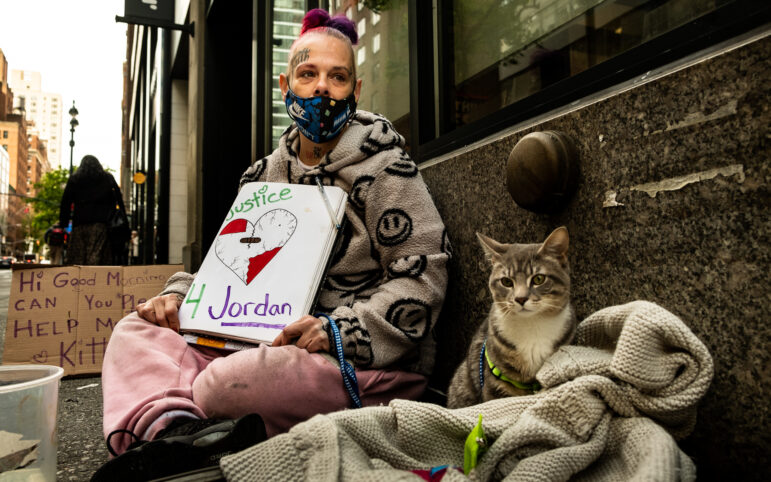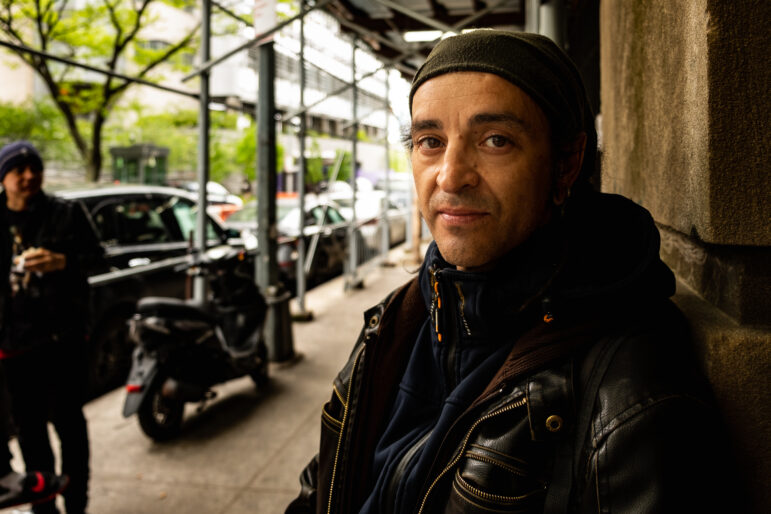“Out there you are vulnerable. It’s safer in here behind doors,” Kevin, who declined to provide his last name, told City Limits outside the 30th Street Intake Shelter Thursday. He is among several currently or formerly homeless New Yorkers to empathize this week with the late Jordan Neely.

Adi Talwar
Shannon Hartman with her cat Makaveli. Hartman said she knew Jordan Neely from spending time around Grand Central, and said he would always ask her how she was doing. “The homeless look out for the homeless,” she said.
Jeffrey Jones can recall how bad he felt at times, riding the subway when he was homeless. Though he has lived in Crown Heights, Brooklyn, for more than a decade now, he was unhoused for more than 20 years.
“I looked at people’s faces and said to myself, ‘Why oh why am I living like this, and why oh why can’t I have a normal life like these people?’” he told City Limits on Thursday while picking up lunch outside of the Atlantic Armory Shelter on Bedford Avenue. “And at times I wanted to be someone else.”
Jones was among several currently or formerly homeless New Yorkers to empathize this week with the late Jordan Neely, a 30-year-old man who died Monday after being put in a chokehold by another subway passenger on the F train in lower Manhattan, an incident that was at least partially captured on video.
According to one witness account posted to Facebook in Spanish, Neely had yelled that he did not have food or drink, and was fed up and didn’t mind going to jail, or dying. The man who choked Neely has not been charged with a crime, though the Manhattan District Attorney has opened an investigation into the incident. The city’s medical examiner has ruled the death a homicide.
Prior to his death, Neely stayed in public spaces, according to Shannon Hartman, who knew him from the area around Grand Central Station. She remembered his Michael Jackson impersonations fondly, and said he would always ask her how she was doing.
“He used to sew his clothes, when he danced, by the bathrooms inside Grand Central. Very sweet man,” she recalled Friday morning, outside of a Dunkin’ Donuts on Lexington Avenue. “He even gave me money. Like, the homeless look out for the homeless. It’s something we do.”
More than 77,000 people slept in a city homeless shelter this week, a number that’s surged over the last year. The number of street homeless New Yorkers is harder to track, though the city’s most recent HOPE census, conducted in January 2022,* estimated there were 3,439 unsheltered residents at the time.
Hartman, sitting alongside her cat Makaveli, laid out a sign with a large heart and the words “Justice 4 Jordan.” She said his killer must be prosecuted: “He needs to go to jail for murder. Because that wasn’t fair.”
Asking for help as a homeless person can be frustrating, according to Hartman, who last saw Neely several months ago. “It’s hard when people continuously tell you no,” she said. “And I don’t want them to blame it on mental health, because it’s not always that.”
Neely was also upset about the death of his mother, she added. Christie Neely was murdered in 2007, according to a GoFundMe launched by Neely’s aunt, Carolyn.
“He was upset about his mom, but that’s so understandable,” Hartman said. “My mom’s alive but my dad died like three years ago, so I understand the pain.”
People trying to make sense of Neely’s killing should consider the pervasiveness of both racial and economic discrimination, according to Jones, of Crown Heights, who did not know Neely personally.
Jones is Black, as was Neely, and the video shows that the man who choked him was white. “If he was a white person with a suit and tie working on Wall Street that wouldn’t have happened to him like that,” Jones said. “They wouldn’t have choked him like that.”
Others who did not know Neely or witness his killing described the need to be alert on the street and in the subway, acting in such a way as to avoid attention.
“To be aware is to be alive,” said Kevin, who declined to provide his last name, standing outside of the 30th Street Intake Shelter for homeless men in Manhattan. “Out there you are vulnerable. It’s safer in here behind doors.”
Another man, who gave the name Chris, said he’d experienced more tension inside a shelter than on the subway in his short time in New York City. “It was a guy who had his stuff stolen or something so he just walked into the waiting room and said, ‘I’m going to slap everybody, and watch when I find the guy who did it,’” he recalled. “It’s kind of fucked up that you gotta deal with that. But that’s life.”

Adi Talwar
Marco Levi visited a shelter intake center this week for employment assistance, fearful he won’t be able to make next month’s rent after losing his job. “I’m one of the few lucky ones that have family support,” he said. “Without support, who knows, you know?”The services in place to help unhoused New Yorkers, from shelters to public hospitals, too often fail them, others said.
Marco Levi visited the 30th Street facility twice this week for employment assistance, fearful that he won’t be able to make next month’s rent after losing his job. He pulled a crumpled flier out of his pocket that was given to him, he said, by staff at the facility. It contained information about where to look for work, but Levi said he had more luck scheduling an interview through the website Indeed at a nearby library.
“The mayor, whatever, the politics guys, they’re hypocrites. Because everything they do is talk, no actions,” Levi said.
Last year, he added, Levi’s doctor at Bellevue Hospital was abruptly transferred and he had to scramble to refill his anxiety medication.
“I was able to find another doctor within two months, but other people who have to wait eight months without medication, going crazy — I’m one of the few lucky ones that have family support,” he said. “Without support, who knows, you know?”
Eugene Manigo, a veteran and chaplain, became homeless during the pandemic and said that he is struggling to find an apartment that will accept his rental voucher.

Adi Talwar
Eugene Manigo near the 30th Street Men’s Intake Shelter in Manhattan.
“I’m actively trying to use my voucher so that I can get out of here and make room for other folks,” he said Thursday outside of the Manhattan intake center.
In the meantime, he added, the services he has encountered are not adequate. He praised Mayor Eric Adams for “focusing on the homeless and their inability to have somewhere to stay,” but said city agencies fall short.
“[Adams] should get the kind of help that’s necessary to supply to these people… other than just scooping them up,” he said.
Both the mayor and New York Gov. Kathy Hochul have focused extensively on the subway and perceptions of public safety since taking office, dispatching hundreds of additional police officers to patrol the transit system as well as outreach workers to connect people, they say, with shelter and mental health resources.
But that approach—which has included removing homeless people from trains and stations, and sweeping homeless encampments in other public spaces—has been heavily criticized by housing advocates who say it’s punitive and doesn’t address the need for greater access to stable, affordable housing.
During the first four months of Adams’ subway safety initiative last year, just around 2 percent of 83,591 underground “engagements” by police and outreach teams led to a person entering a shelter, City Limits’ reporting found. The mayor said Thursday that the effort, to date, has resulted in around 4,000 people receiving services.
“I’m going to let the investigation run its course,” the mayor said when asked about Neely’s death Thursday, defending his administration’s policy of removing unsheltered people from the transit system.
“Every circumstance is different, but we need to be extremely clear that from day one of this administration I focused on—we cannot have people with severe emotional illnesses on our subway system,” Adams said. “We should not wait until something happens with someone and then react.”
City Limits did not speak to anyone with direct knowledge of Neely’s mental health status, though Gothamist reported that he struggled with mental illness. The Daily News interviewed a man who described being punched by Neely in 2019, and said that he should have received rehabilitation at the time.
Cruz Mendoza spoke to City Limits outside of the Atlantic Armory Shelter in Crown Heights Thursday, having arrived there from Rikers Island the week prior. He had been incarcerated for five years, and described living with PTSD and Bipolar Disorder.
Mendoza took deescalation classes while he was incarcerated, and said more New Yorkers should do the same. “I think for every community, it should be informed how to deal with that situation without violence,” he said. “While I was in jail I took courses…for people like myself who have mental issues. And the way I see it—you shouldn’t pin down a person who has mental illness. You can make it worse.”
The city should deploy more mental health professionals on the subway, Jones added.
“You need special people to work with MTA, with the police, or by themselves with an escort, so no harm comes to them,” he said. “And then have medical people standing by.”
Tom Brucee, who visited the 30th Street intake center Thursday, said he has noticed more police on the trains recently, but that they don’t appear to be doing much. “They be watching movies on their phone,” he said. “They’re not doing shit. So does it make a difference? Nah, not really.”
Hartman, Neely’s friend, agreed. “What’s the point of the police being in every station if they’re not there to help?” she said Friday. “It’s a waste of money.”
When she encounters a tense situation on the subway, Hartman added, she has a solution that’s worked in the past. “Just pay attention, that’s all,” she said. “If you don’t feel safe, move to another car. That’s what I do.”
With additional reporting by Jeanmarie Evelly.
*This story has been updated to correct the date for the HOPE census; the most recent publicly available data is from January 2022, not this year.









6 thoughts on “‘Justice 4 Jordan’: New Yorkers Who’ve Experienced Homelessness React to Subway Killing”
How many times was Neely arrested?
Thanks for putting our words necessary for attention with the readers. I believe that yesterday’s interviews will speak volume. I intend to share this article with friends. Be blessed, Chaplain Manigo
My local homeless were offered job help. It was refused. Street life seems to be preferred.
Jordan’s plight is similar to that of almost half a million Americans who are homeless across the country. Dehumanization of homeless individuals, such as Jordan, can portray them as disposable and devoid of human decency.
I intend to share this article with friends. Be blessed, Chaplain Manigo
Thanks…
I believe that yesterday’s interviews will speak volume. I intend to share this article with friends. Be blessed, Chaplain Manigo